The Simultaneous Interpolation of Target Radar Cross Section in Both the Spatial and Frequency Domains by Means of Legendre Wavelets Model-Based Parameter Estimation
Abstract
The understanding of the target radar cross section (RCS) is significant for target identification and for radar designing and optimization. In this paper, a numerical algorithm for calculating target RCS is presented which is based on Legendre wavelet model-based parameter estimation (LW-MBPE). The Padé rational function fitting model applied for MBPE in the frequency domain is enhanced to include spatial dependence on the numerator and denominator coefficients. This allows the function to interpolate target RCS in both the frequency and spatial domains simultaneously. The combination of Legendre wavelets guarantees the convergence of the algorithm. The method is convergent by increasing the sampling frequency and spatial points. Numerical results are provided to demonstrate the validity and applicability of the new technique.
1. Introduction
In modern electronic warfare, stealth technology is the main technique used to reduce radar detection probability and enhance the survivability of aircrafts [1, 2]. RCS reduction is the key factor to measure stealth performance of the aircraft. RCS reduction techniques of aircraft generally fall into one of four categories [3, 4]: materials selection and coating, target shaping, passive cancellation, and active cancellation. Active cancellation stealth is a significant research direction in the field of stealth. The creation of a large RCS database of target is the key process in active cancellation [5–7]. However, although the parallel technology of computer is rapidly developing, it is still an arduous task to create a large RCS database containing both frequency and spatial domain information. In recent years, the model-based parameter estimation (MBPE) [8–10] is combined with the method of moments (MoM) to minimize the computational cost. This method is widely used in solving the calculation of target RCS problems [11, 12]. Since it includes the frequency and spatial domain information, it is also used to store and predict target RCS and create RCS database. A lot of articles describe in detail the theory behind the MBPE interpolation process [13, 14]. In [12], the modeling, sampling, and solution of MBPE for both frequency and domain problems are described.
Wavelet analysis is a new and an emerging area in engineering and mathematical research [15]. Wavelets are used in optimal control, system analysis, signal analysis, numerical analysis, and fast algorithms for easy implementation. Functions are decomposed into summation of “basic functions,” and every “basic function” is achieved by compression and translation of a mother wavelet function with good properties of smoothness and locality, which makes people analyze the properties of locality and integer in the process of expressing functions [16, 17].
In this work, a numerical method based on the Legendre wavelets MBPE is proposed to compute target RCS approximately. A generalized Padé rational function fitting model that can be used to interpolate both frequency and spatial characteristics of RCS simultaneously is enhanced. Convergence analysis of the Legendre wavelets MBPE is investigated. Numerical results demonstrate the efficiency of this method in solving target RCS.
2. Legendre Wavelets
3. Legendre Wavelets Model-Based Parameter Estimation Method
Theorem 1. Suppose that the function Fk,M(θ′, sl) obtained by using Legendre wavelets is the approximation of F(θ′, sl), and F(θ′, sl) is with bounded second derivative; then one has the following upper bound of error:
Proof. See Appendix A.
From this theorem, we can see clearly that when M is fixed and k → +∞.
Theorem 2. Suppose that the function obtained by using Legendre wavelets is the approximation of F(θ, φ, sl), and F(θ, φ, sl) has bounded mixed fractional partial derivative ; then one has the following upper bound of error:
Proof. See Appendix B.
From this theorem, we can see that when k → +∞.
4. Numerical Results
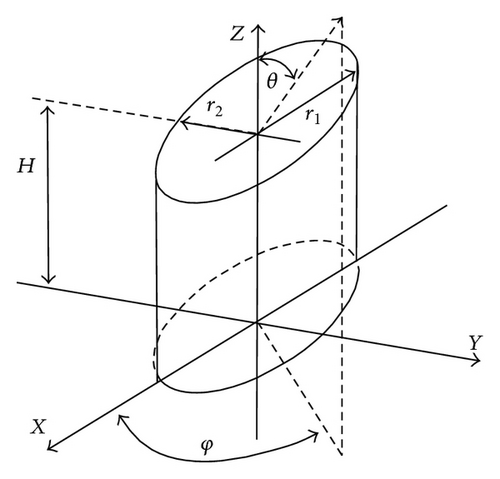

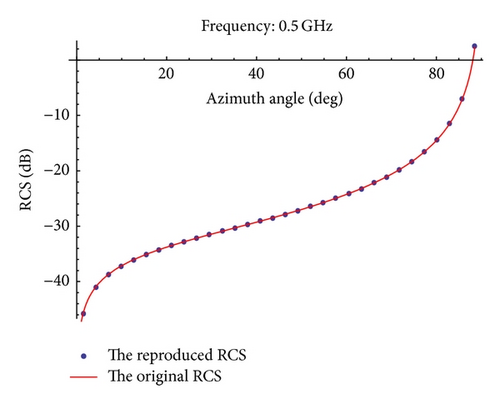
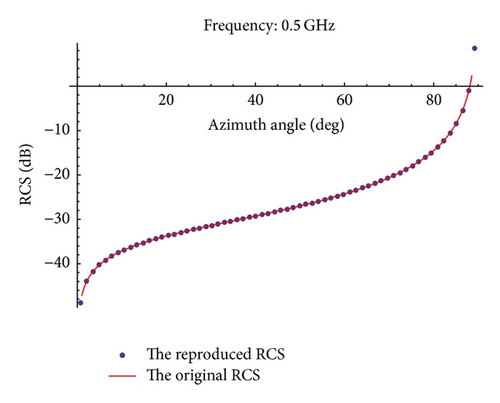
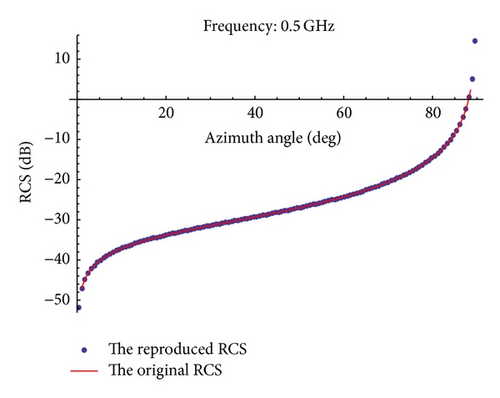
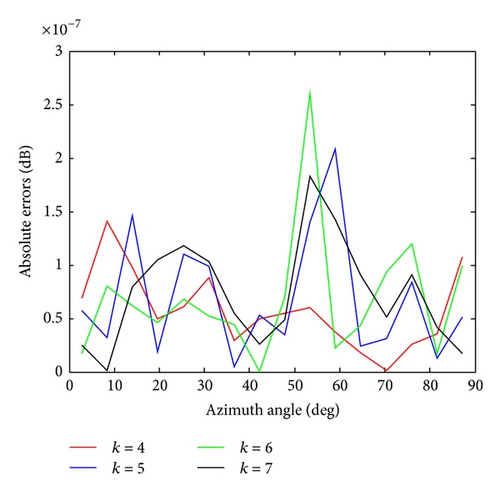
Table 1 shows the absolute errors between the original RCS and the reproduced RCS. From Table 1, we can also see that the errors are smaller and smaller when k increases.
| θ × 90° | k = 4 | k = 5 | k = 6 | k = 7 |
|---|---|---|---|---|
| 0.1 | 0.00874 | 0.00540 | 0.00079 | 0.00035 |
| 0.2 | 0.02334 | 0.00354 | 0.00157 | 0.00019 |
| 0.3 | 0.03044 | 0.00348 | 0.00177 | 0.00024 |
| 0.4 | 0.02269 | 0.00924 | 0.00112 | 0.00055 |
| 0.5 | 0.25790 | 0.05183 | 0.01178 | 0.00281 |
| 0.6 | 0.03000 | 0.01726 | 0.00251 | 0.00113 |
| 0.7 | 0.11124 | 0.01937 | 0.00794 | 0.00097 |
| 0.8 | 0.32609 | 0.02837 | 0.01630 | 0.00237 |
| 0.9 | 6.49094 | 0.32208 | 0.02801 | 0.01609 |
The interpolated RCS as a function of azimuth angle θ and pitching angle φ is shown in Figures 7–10 for . The elliptical cylinder backscattered RCS using (23) is also shown in Figure 11. Table 2 shows the absolute errors between the original RCS and the reproduced RCS for different values of θ, φ, and .
| (θ × 90°, φ × 45°) | ||||
|---|---|---|---|---|
| (0.1, 0.1) | 0.01014 | 0.00610 | 0.00084 | 0.00041 |
| (0.2, 0.2) | 0.02629 | 0.00398 | 0.00176 | 0.00021 |
| (0.3, 0.3) | 0.03376 | 0.00383 | 0.00208 | 0.00031 |
| (0.4, 0.4) | 0.02468 | 0.01020 | 0.00132 | 0.00059 |
| (0.5, 0.5) | 0.27407 | 0.05570 | 0.01286 | 0.00302 |
| (0.6, 0.6) | 0.03233 | 0.01845 | 0.00270 | 0.00122 |
| (0.7, 0.7) | 0.11657 | 0.01995 | 0.00828 | 0.00102 |
| (0.8, 0.8) | 0.33268 | 0.02912 | 0.01669 | 0.00241 |
| (0.9, 0.9) | 6.49592 | 0.32396 | 0.02837 | 0.01616 |
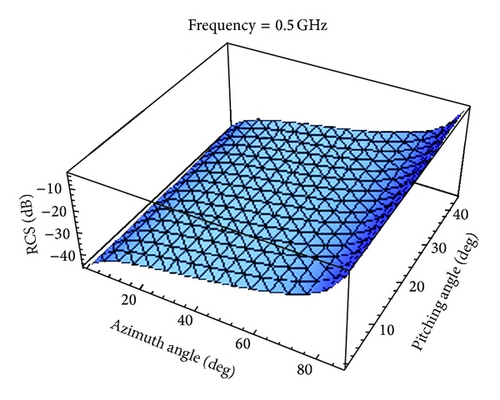
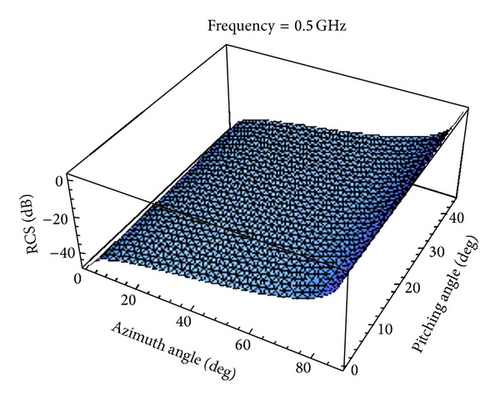
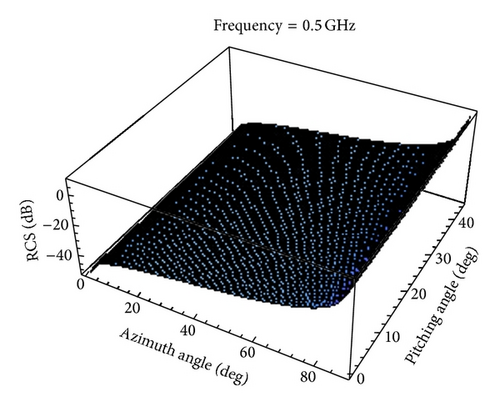
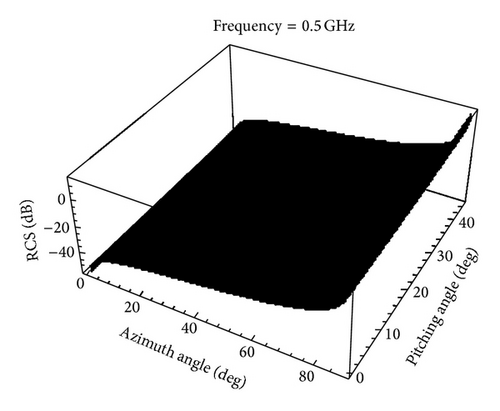
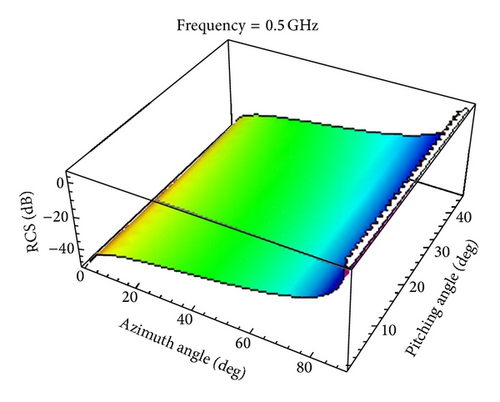
We can see that the reproduced RCS is more and more close to the original RCS with the value of becoming large by taking a closer look at Figures 7–11 and Table 2.
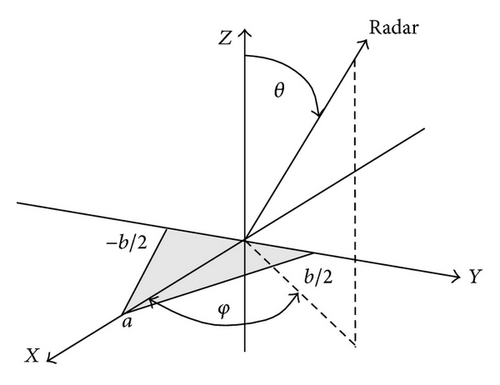
Based on a perfectly conducting isosceles triangular flat plate, Figures 13, 14, 15, and 16 show the normalized backscattered RCS using (26) and the reproduced RCS using LW-MBPE for k = 4,5, 6,7. The absolute errors for the reproduced RCS and original RCS in Figures 13–16 are shown in Figure 17.
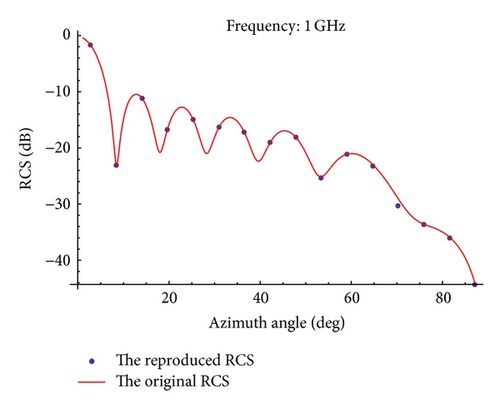
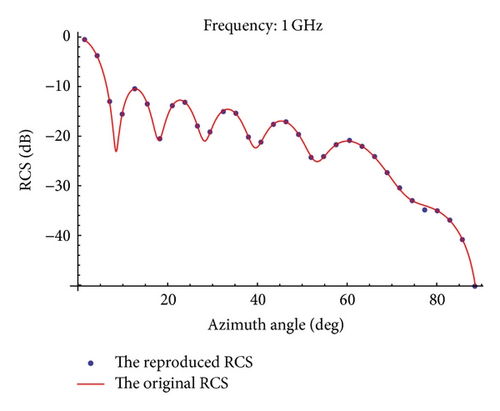
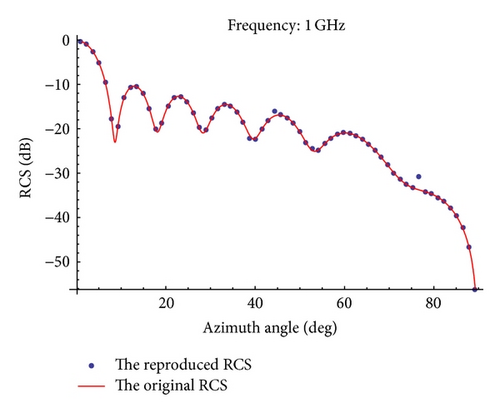
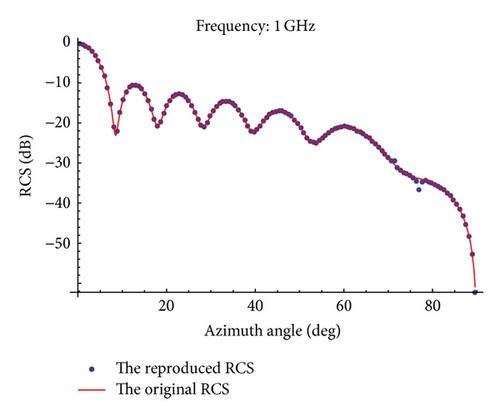
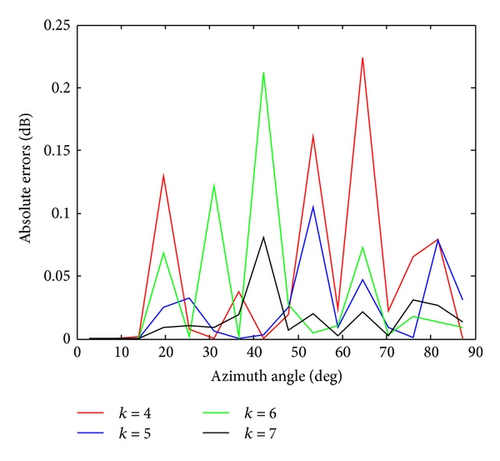
Table 3 shows the absolute errors between the original RCS and the reproduced RCS. From Table 3, we can also find that the errors are smaller and smaller with k increasing.
| θ × 90° | k = 4 | k = 5 | k = 6 | k = 7 |
|---|---|---|---|---|
| 0.1 | 8.54737 | 5.98691 | 0.86121 | 0.56261 |
| 0.2 | 6.56903 | 1.79307 | 1.08659 | 0.14338 |
| 0.3 | 3.55198 | 0.15870 | 0.04182 | 0.01021 |
| 0.4 | 0.69205 | 0.03673 | 0.03452 | 0.00126 |
| 0.5 | 0.33927 | 0.10280 | 0.02992 | 0.01416 |
| 0.6 | 2.76694 | 0.71435 | 0.21953 | 0.00813 |
| 0.7 | 0.61607 | 0.03730 | 0.01911 | 0.00141 |
| 0.8 | 0.04907 | 0.01372 | 0.00938 | 0.00182 |
| 0.9 | 0.09652 | 0.07825 | 0.05342 | 0.04251 |
The interpolated RCS as a function of azimuth angle θ and frequency is shown in Figures 18–21 for different .
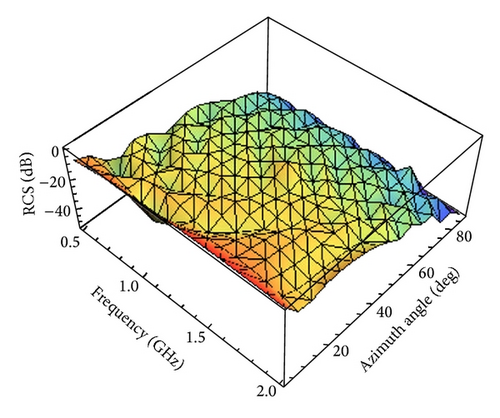
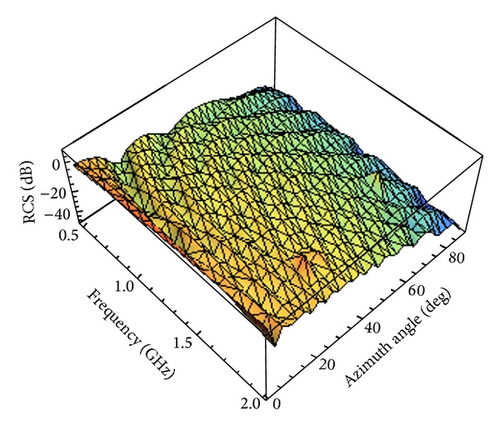
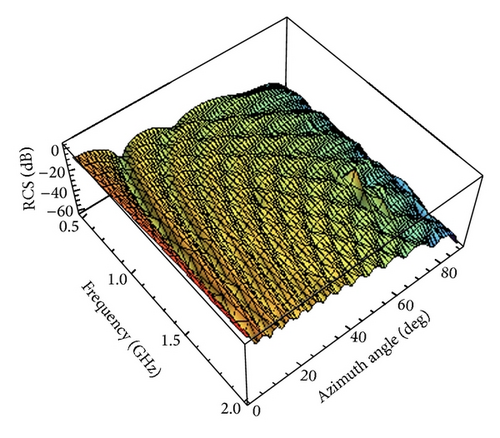
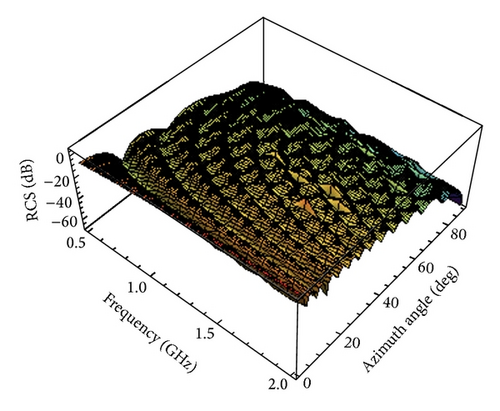
According to the above analysis, we can acquire the approximate backscattered RCS of the perfectly conducting triangular flat plate for arbitrary θ and frequency by using LW-MBPE method. What is more, the approximations are more and more accurate with increasing. It is evident from the examples that the LW-MBPE method is convergent.
In the two examples, the approximate formulas of the target backscattered RCS are known. However, in practical, the majority of targets backscattered RCS are unknown, and approximate formulas cannot be found. We can also obtain the value of RCS of sampling points by using the method of moments (MoM).
5. Conclusion
In this paper, a scheme to interpolate target RCS in both the frequency and spatial domains simultaneously using LW-MBPE method was proposed. The Padé rational function fitting model used for MBPE in the frequency domain can be easily modified to include spatial dependence on its numerator and denominator coefficients. This interpolation technique was applied to two examples, an elliptical cylinder and a perfectly conducting triangular flat plate; in each case, the modified Padé rational function yielded excellent coincidence with the exact results calculated using their RCS formulas. The results also show that the proposed method is convergent with sampling points increasing.
Nomenclature
-
- ψnm(x):
-
- Legendre wavelets function
-
- Pm(x):
-
- Legendre polynomials
-
- ci, uij:
-
- Wavelets coefficients
-
- F(s):
-
- Padé rational function
-
- :
-
- Padé rational function coefficients
-
- θ:
-
- Azimuth angle
-
- φ:
-
- Pitching angle
-
- σ:
-
- Radar cross section
-
- f:
-
- Frequency
-
- :
-
- Positive integer
-
- Pi:
-
- Power density, or intensity, of a plane wave striking the target
-
- Ps:
-
- Power per unit solid angle reflected by the target.
Conflict of Interests
There is no conflict of interests related to this paper.
Acknowledgment
This work was supported by the National Natural Science Foundation of China under Grant no. 51307004.
Appendices
A. The proof of Theorem 1
Proof. Let F(θ′, sl) be a function defined on [0,1] such that
The orthonormality of sequence {ψnm(θ′)} on [0,1) implies that , where I is the identity matrix; then
B. The proof of Theorem 2
Proof. The orthonormality of the sequence {ψi(θ)} on [0,1) implies that , where I is the identity matrix; then
So we have
Then we get




